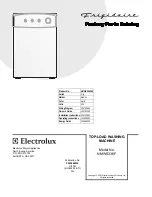
Table continued from last page
Action
Possible causes
Problem
Avoid large packages.
Old detergent. Detergent is a
perishable product.
Do not cover porcelain with
large bowls or the like. Avoid
placing very tall glasses in the
corners of the baskets.
Dishes loaded incorrectly.
Place dishes to sit steady.
Glasses and cups have toppled
over during the program.
Check that the filter handle is
locked in the stop position.
The filters are not fitted cor-
rectly.
Check that the coloured stop
on the right in the bottom drain
is in place. See the chapter Care
and cleaning.
Drainage pump stop missing.
Rinse off these types of food-
stuffs if not starting the dish-
washer immediately. Consider
using the One hour program
program with the SpeedWash
option.
Some foodstuffs, such as mus-
tard, mayonnaise, lemon, vineg-
ar, salt and dressings, can
cause spots on stainless steel
if left for too long.
Spots on stainless steel or sil-
ver.
In order to avoid marks and tar-
nishing, separate dishes made
from different metals, such as
silver, stainless steel and alu-
minium.
All stainless steel can cause
spots on silver if they come into
contact during dishwashing.
Aluminium can also cause spots
on dishes.
Check that the salt compart-
ment lid is properly tightened.
Otherwise call the service de-
partment.
The water softener is leaking
salt.
Spots or films on the dishes.
See the chapter Settings.
Incorrect water softener setting.
See the chapter Settings.
Incorrect rinse aid dosage set-
ting.
Top up with salt. See the
chapter Before washing for the
first time.
Salt compartment empty.
Inactivate the setting TAB (3-in-
1/ All-in-one detergent) and top
up salt and rinse aid.
3-in-1/ All-in-one detergent is
used and the setting TAB (3-in-
1/ All-in-one detergent) is activ-
ated.
Wash crystal at a low temperat-
ure and with a conservative
amount of detergent. Contact
the detergent manufacturer.
Too high temperature and/or
too much detergent can cause
etching on crystal. Unfortu-
nately, this cannot be repaired,
only prevented.
28









































